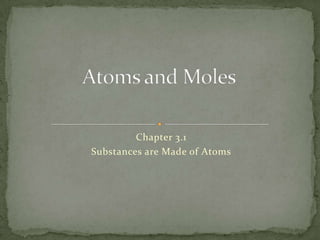Applied Chapter 3.1 : Substances are Made of Atoms
•Download as PPTX, PDF•
0 likes•1,624 views
The document discusses the laws and principles that support the atomic theory of matter. It outlines three laws: the law of definite proportions, the law of conservation of mass, and the law of multiple proportions. It also lists the five principles of John Dalton's atomic theory, which include that all matter is made of atoms, atoms are identical within an element but different between elements, atoms cannot be created or destroyed, atoms combine in whole number ratios, and atoms are rearranged in chemical reactions.
Report
Share
Report
Share

Recommended
U2L6 - Interactions of Atoms

Science Fusion PowerNotes - Grade 8
Unit 2 Lesson 6 - Interactions of Atoms
Recommended
U2L6 - Interactions of Atoms

Science Fusion PowerNotes - Grade 8
Unit 2 Lesson 6 - Interactions of Atoms
Class xi chemistry (chapter 1) converted

Class 11 chemistry chapter 1 notes compiled for both Kerala state board students and CBSE students.
Chapter 3

First Year in Dentistry First Semester
Al-Azhar University - Gaza
Lama El Banna
general chemistry
Basic concept of Chemistry

Presentation is for the first chapter of class 11th Chemistry CBSE board. Presentation is having detailed description for some of the basic concepts like mole concept, matter in our surrounding etc.
More Related Content
What's hot
Class xi chemistry (chapter 1) converted

Class 11 chemistry chapter 1 notes compiled for both Kerala state board students and CBSE students.
Chapter 3

First Year in Dentistry First Semester
Al-Azhar University - Gaza
Lama El Banna
general chemistry
Basic concept of Chemistry

Presentation is for the first chapter of class 11th Chemistry CBSE board. Presentation is having detailed description for some of the basic concepts like mole concept, matter in our surrounding etc.
What's hot (20)
Similar to Applied Chapter 3.1 : Substances are Made of Atoms
Class 9 atom and molecules

class 9 chemistry atom and molecules are explained briefly in a simple language.
Mole concept molar mas etc are described.
PhySci-01-Unit-1-Chapter-1-Lesson-1.3-Atoms-from-the-Eyes-of-Philosophers-and...

Timeline of the history of atoms
Chemical Bonds & The Laws of Chemical Bonding

Chemical Bonds & The Laws of Chemical Bonding for 9th grade Philippine students
Atoms and molecules

atoms and molecules study material class 9
please consider to follow it gives me education only 1 % of viewers are following its free !
Laws of chemical combination, Grade XI and XII

Dalton's atomic theory, Laws of stoichiometry and their statement, Mole concept, Avogadro's hypothesis and applications, Limiting reagent, Theoretical yield, experimental yield and percentage yield, Molecular formula and empirical formula and their determination.
Similar to Applied Chapter 3.1 : Substances are Made of Atoms (20)
PhySci-01-Unit-1-Chapter-1-Lesson-1.3-Atoms-from-the-Eyes-of-Philosophers-and...

PhySci-01-Unit-1-Chapter-1-Lesson-1.3-Atoms-from-the-Eyes-of-Philosophers-and...
More from Chris Foltz
More from Chris Foltz (20)
Applied Chapter 3.1 : Substances are Made of Atoms
- 1. Chapter 3.1 Substances are Made of Atoms Atoms and Moles
- 2. Objective 1: State the three laws that support the existence of atoms. Law of Definite Proportions States that a chemical compound contains the same proportions by mass regardless of the size of the sample or source of the compound Sodium Chloride – Always 39.34 % Na by mass 60.66% Cl by mass
- 3. Law of conservation of mass States that mass is neither destroyed nor created during ordinary chemical reactions or physical changes. If you start with 12 g of reactant, you will be left with 12 grams of product Law of multiple Proportions If 2 or more different compounds are composed of the same two elements, then the ratio of the masses of the second element combined with a certain mass of the element is always a ratio of small whole numbers Ex: NO2 , N2O4 CO , CO2
- 4. Objective 2List the five principles of John Dalton’s atomic theory Dalton’s Atomic Theory In 1808, and English School teacher, John Dalton came up with these assumptions of the atom. All matter is composed of extremely small particles called atoms Atoms of a given element are identical in size, mass, and other properties Atoms cannot be subdivided, created, or destroyed. Atoms of different elements combine in simple whole-number ratios to form chemical compounds In chemical reactions, atoms are combined, separated, or rearranged.